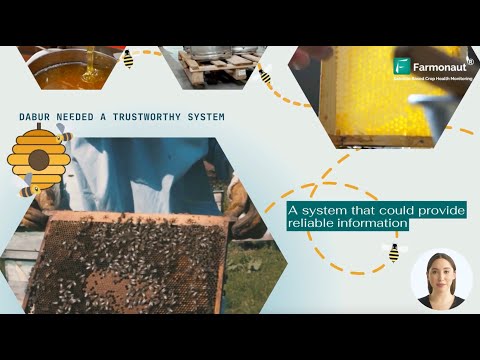Breaking News: US-India Trade Relations Shift as Agricultural Tariffs Set to Drop Substantially

“India’s agricultural tariffs on certain US products have exceeded 100%, significantly impacting bilateral trade relations.”
In a groundbreaking development that’s set to reshape the landscape of international trade, the United States and India are on the brink of a significant shift in their trade relations. As agricultural tariffs between these two economic giants are poised to drop substantially, we’re witnessing a pivotal moment in global commerce that could have far-reaching implications for farmers, businesses, and consumers alike.
At Farmonaut, we understand the critical role that trade policies play in shaping agricultural markets. As a company dedicated to empowering farmers through advanced satellite-based farm management solutions, we’re keenly aware of how changes in tariffs can impact the entire agricultural supply chain. Let’s delve into this unfolding story and explore what it means for the future of US-India trade relations and the global agricultural sector.
The Current Landscape of US-India Trade Relations
For years, the trade relationship between the United States and India has been characterized by high tariffs and trade barriers, particularly in the agricultural sector. These tariffs have acted as significant obstacles to free trade, limiting market access and driving up costs for consumers in both countries.
- India has imposed tariffs as high as 100% on certain US agricultural products
- The US has responded with its own set of tariffs on Indian goods
- These trade barriers have strained diplomatic and economic relations between the two nations
The impact of these high tariffs has been particularly felt in key agricultural sectors such as rice, dairy, butter, and cheese. For instance, India’s 100% tariff on US agricultural products has made it virtually impossible for American farmers to compete in the Indian market, while reciprocal tariffs have similarly affected Indian exporters.
The Push for Reciprocity and Tariff Reduction
Recent statements from US President Donald Trump have indicated a significant shift in this status quo. Trump announced that India will be “dropping its tariffs very substantially,” a move that could herald a new era in US-India trade relations. This development comes as part of a broader push for reciprocity in international trade policies.
Key points from Trump’s announcement:
- India is expected to substantially reduce its tariffs on US goods
- The US is preparing to announce reciprocal tariffs on various countries
- These changes are set to take effect on April 2
This move towards reciprocity is not limited to India. Trump also mentioned that other countries, including those in the European Union, have already begun to reduce their tariffs on US products. For instance, the EU has reportedly dropped its tariff on cars to 2.5%.
The Potential Impact on Agricultural Markets
“The potential drop in US-India agricultural tariffs could affect global markets for rice, dairy, butter, and cheese worth billions.”
The anticipated reduction in agricultural tariffs between the US and India could have significant implications for global markets, particularly in sectors such as rice, dairy, butter, and cheese. Here’s how these changes might affect different aspects of the agricultural industry:
1. Market Access and Competition
Reduced tariffs would open up new opportunities for farmers and agribusinesses in both countries. US dairy farmers, for instance, could gain better access to India’s vast market of over 1.3 billion consumers. Similarly, Indian rice exporters might find it easier to compete in the US market.
2. Price Dynamics
As trade barriers fall, we could see changes in the pricing of agricultural products. Increased competition and reduced import costs might lead to lower prices for consumers, while also potentially putting pressure on domestic producers to remain competitive.
3. Supply Chain Restructuring
The shift in tariffs could prompt a restructuring of global agricultural supply chains. Companies might reassess their sourcing strategies, potentially leading to new partnerships and trade routes between the US and India.
4. Innovation and Efficiency
Increased competition often drives innovation and efficiency. Farmers and agribusinesses in both countries might be incentivized to adopt new technologies and practices to stay competitive in a more open market.
At Farmonaut, we’re particularly interested in how these changes might drive adoption of precision agriculture technologies. Our crop plantation and forest advisory services could become even more valuable as farmers seek to optimize their operations in a more competitive global market.
Comparative Tariff Rates on Key Agricultural Products
| Product Category | Current US Tariff on Indian Imports | Current Indian Tariff on US Imports | Proposed US Tariff | Proposed Indian Tariff |
|---|---|---|---|---|
| Rice | 11.2% | 70% | 5% | 25% |
| Dairy Products | 17.5% | 60% | 7.5% | 20% |
| Butter | 12.3% | 40% | 6% | 15% |
| Cheese | 15% | 30% | 7% | 12% |
This table illustrates the potential scale of tariff reductions being discussed. It’s important to note that these are estimated figures based on current discussions and may be subject to change as negotiations progress.
The Role of Technology in Adapting to New Trade Realities
As trade barriers fall and global competition intensifies, farmers and agribusinesses will need to leverage technology to stay competitive. This is where Farmonaut’s suite of advanced agricultural solutions comes into play.
- Satellite-Based Crop Health Monitoring: Our real-time crop health monitoring system can help farmers optimize their yields and quality, crucial for competing in a more open global market.
- AI-Driven Advisory Systems: Our Jeevn AI advisory system provides personalized recommendations, helping farmers make data-driven decisions to improve productivity and efficiency.
- Blockchain-Based Traceability: In an era of increased cross-border trade, our blockchain-based traceability solutions can help ensure transparency and build trust in international supply chains.
- Resource Management Tools: Our fleet and resource management tools can help agribusinesses optimize their operations, crucial for maintaining competitiveness in a changing trade landscape.
These technologies can play a vital role in helping farmers and agribusinesses adapt to the new realities of international trade, ensuring they can compete effectively in a more open global market.
The Broader Implications for International Trade
The potential reduction in US-India agricultural tariffs is not occurring in isolation. It’s part of a broader trend towards reassessing and potentially restructuring international trade policies. This shift could have far-reaching implications for global trade relations:
1. Precedent for Other Trade Partnerships
The US-India tariff reductions could set a precedent for other trade relationships. We might see a domino effect, with other countries reassessing their tariff structures to remain competitive in the global market.
2. Shift in Global Trade Dynamics
As major economies like the US and India adjust their trade policies, we could see a shift in global trade dynamics. This could lead to the formation of new trade alliances and the restructuring of existing ones.
3. Impact on Developing Economies
Changes in US-India trade relations could have significant implications for developing economies. Some might benefit from increased market access, while others might face increased competition in sectors where they previously held advantages.
4. Push for Further Trade Liberalization
The move towards reciprocity and tariff reduction could fuel a broader push for trade liberalization. This could potentially lead to more comprehensive trade agreements and further reduction of trade barriers globally.
At Farmonaut, we’re committed to helping farmers navigate these changing trade dynamics. Our crop loan and insurance services can provide crucial financial support and risk management tools as farmers adapt to new market realities.
Challenges and Opportunities
While the potential reduction in agricultural tariffs presents significant opportunities, it also comes with challenges that need to be addressed:
Challenges:
- Adjustment Period: Farmers and businesses in both countries will need time to adapt to the new trade environment.
- Domestic Market Pressures: Increased competition could put pressure on domestic producers, potentially leading to consolidation in some sectors.
- Regulatory Harmonization: Differences in food safety standards and regulations between the US and India will need to be addressed.
- Infrastructure and Logistics: Expanding trade will require improvements in infrastructure and logistics capabilities in both countries.
Opportunities:
- Market Expansion: Reduced tariffs open up new markets for farmers and agribusinesses in both countries.
- Innovation Drive: Increased competition could spur innovation in agricultural practices and technologies.
- Consumer Benefits: Lower tariffs could lead to more choices and potentially lower prices for consumers.
- Economic Growth: Expanded trade could contribute to economic growth and job creation in both countries.
To help farmers capitalize on these opportunities and navigate the challenges, Farmonaut offers a range of solutions. Our carbon footprinting tools, for instance, can help agribusinesses meet evolving sustainability requirements in international markets.
The Path Forward: Navigating the New Trade Landscape
As we move towards this new era of US-India trade relations, it’s crucial for all stakeholders – from policymakers to farmers – to prepare for the changes ahead. Here are some key considerations:
1. Policy Implementation
The success of these tariff reductions will depend heavily on how they are implemented. Clear timelines, transparent processes, and effective communication will be crucial to ensure a smooth transition.
2. Support for Affected Sectors
Some sectors may face increased competition as a result of these changes. Governments should consider providing support and transition assistance to help affected industries adapt.
3. Investment in Infrastructure
To fully capitalize on the benefits of increased trade, both countries will need to invest in infrastructure improvements, particularly in areas like transportation and storage facilities for agricultural products.
4. Fostering Innovation
Encouraging innovation in the agricultural sector will be crucial for maintaining competitiveness. This could involve increased investment in agricultural research and development, as well as support for the adoption of new technologies.
At Farmonaut, we’re committed to supporting farmers through this transition. Our large-scale farm management solutions can help agribusinesses optimize their operations and stay competitive in this evolving landscape.
The Role of Technology in the New Trade Era
As we navigate this new era of reduced agricultural tariffs and increased international competition, technology will play a crucial role in helping farmers and agribusinesses adapt and thrive. Farmonaut’s suite of advanced agricultural solutions is particularly well-suited to address the challenges and opportunities presented by this evolving trade landscape.
1. Precision Agriculture for Competitive Advantage
Our satellite-based crop health monitoring system provides farmers with real-time data on their crops, allowing for precise management of resources like water and fertilizers. This level of precision can help farmers optimize their yields and quality, giving them a competitive edge in both domestic and international markets.
2. AI-Driven Insights for Strategic Decision Making
The Jeevn AI advisory system offers personalized recommendations based on a wealth of data, including satellite imagery, weather forecasts, and historical crop performance. These insights can help farmers make informed decisions about what to plant, when to harvest, and how to manage their crops, crucial for success in a more competitive global market.
3. Blockchain for Trust and Transparency
In an era of increased cross-border trade, transparency and traceability become even more important. Our blockchain-based traceability solutions can help ensure the authenticity and quality of agricultural products as they move through international supply chains, building trust with buyers and consumers around the world.
4. Resource Optimization for Cost Competitiveness
Our fleet and resource management tools can help agribusinesses optimize their operations, reducing costs and improving efficiency. This can be particularly valuable as businesses look to remain cost-competitive in a market with reduced trade barriers.
Preparing for the Future: Strategies for Success
As we look towards the implementation of these tariff reductions, it’s crucial for farmers and agribusinesses to prepare for the changes ahead. Here are some strategies to consider:
1. Embrace Technology
Investing in advanced agricultural technologies can help improve productivity and competitiveness. Consider adopting solutions like Farmonaut’s satellite-based crop monitoring and AI advisory systems to optimize your operations.
2. Focus on Quality and Differentiation
As markets become more open, focusing on product quality and differentiation can help maintain a competitive edge. Use data-driven insights to improve crop quality and consider exploring niche or high-value markets.
3. Build Strong Supply Chain Relationships
Developing strong relationships with partners across the supply chain, both domestically and internationally, can help ensure smooth operations in a more interconnected market.
4. Stay Informed
Keep up-to-date with the latest developments in trade policies and market trends. This knowledge can help inform strategic decisions and allow for quicker adaptation to changes.
5. Explore New Markets
As trade barriers fall, consider exploring new export opportunities. Use market data and insights to identify promising new markets for your products.
At Farmonaut, we’re committed to supporting farmers and agribusinesses through this transition. Our comprehensive suite of tools and services can help you navigate these changes and thrive in the new trade landscape.
Conclusion: A New Chapter in US-India Agricultural Trade
The potential reduction in agricultural tariffs between the US and India marks the beginning of a new chapter in international trade relations. While challenges lie ahead, this shift also presents significant opportunities for farmers, agribusinesses, and consumers in both countries.
As we move forward, the role of technology in agriculture will become increasingly crucial. Solutions like those offered by Farmonaut – from satellite-based crop monitoring to AI-driven advisories and blockchain traceability – will be key in helping stakeholders adapt to and thrive in this new trade environment.
We at Farmonaut are excited about the possibilities this new era presents and are committed to supporting our clients through these changes. By leveraging cutting-edge technology and data-driven insights, we believe that farmers and agribusinesses can not only navigate these changes successfully but also find new opportunities for growth and success in the global marketplace.
As this story continues to unfold, we’ll be closely monitoring developments and updating our services to ensure we’re providing the most relevant and effective solutions for our clients in this evolving trade landscape.
FAQs
- How will the reduction in agricultural tariffs affect farmers in the US and India?
The reduction in tariffs is expected to open up new market opportunities for farmers in both countries. However, it may also lead to increased competition, requiring farmers to focus on efficiency and quality to remain competitive. - When will these tariff changes take effect?
According to recent announcements, the changes are set to take effect on April 2. However, the exact timeline and implementation details may be subject to further negotiations and announcements. - Which agricultural products are likely to be most affected by these changes?
Based on current information, products like rice, dairy, butter, and cheese are likely to see significant impacts from the tariff reductions. - How can farmers prepare for these changes in trade policies?
Farmers can prepare by staying informed about policy changes, investing in technology to improve efficiency, focusing on product quality and differentiation, and exploring new market opportunities. - What role will technology play in this new trade environment?
Technology will be crucial in helping farmers and agribusinesses adapt to the new trade landscape. Solutions like precision agriculture, AI-driven insights, and blockchain traceability can help improve efficiency, quality, and transparency in agricultural operations.
Earn With Farmonaut: Earn 20% recurring commission with Farmonaut’s affiliate program by sharing your promo code and helping farmers save 10%. Onboard 10 Elite farmers monthly to earn a minimum of $148,000 annually—start now and grow your income!
Learn more about our affiliate program







